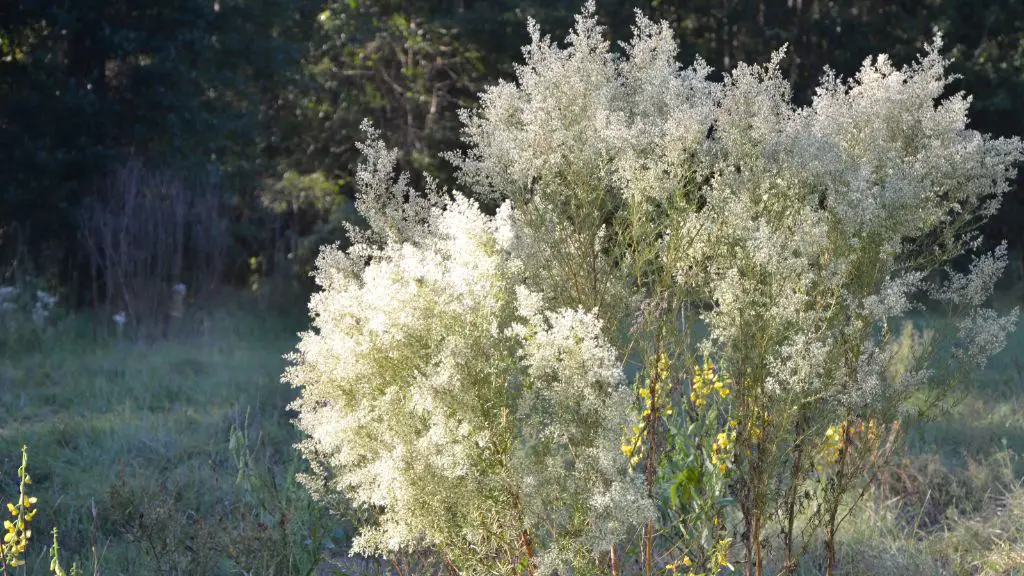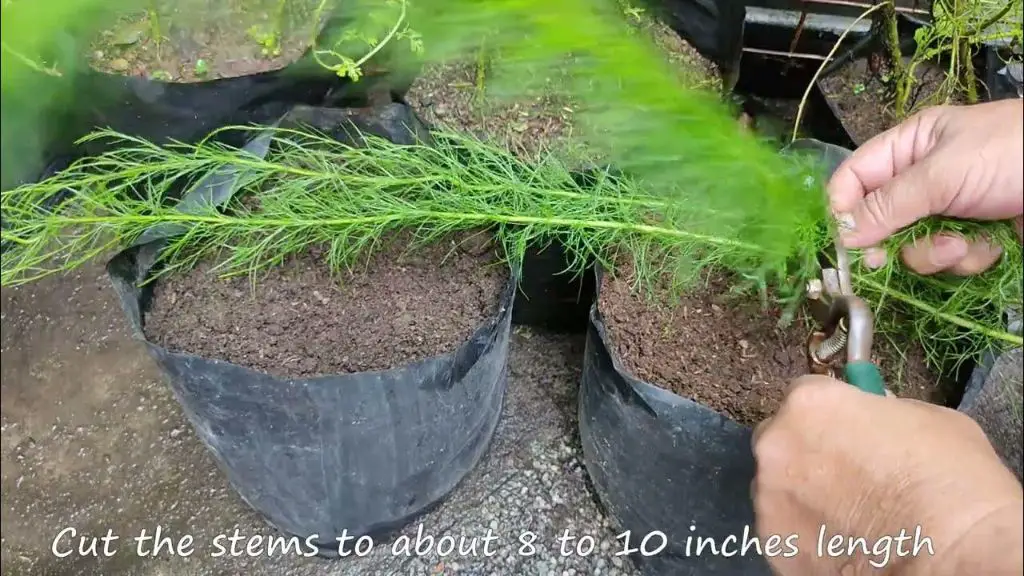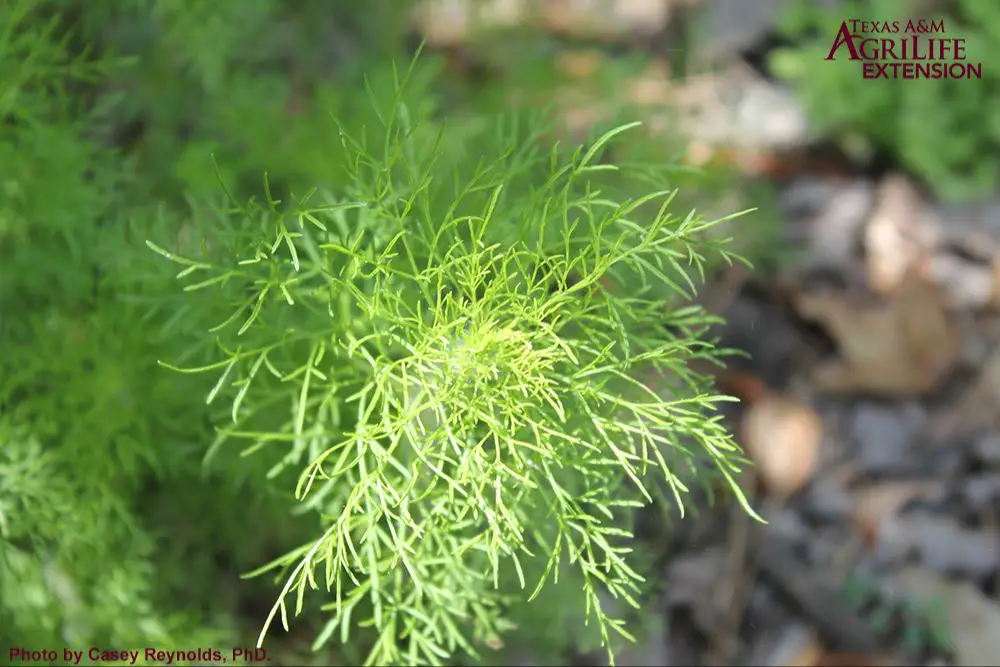What is Dog Fennel?
Dog Fennel (Eupatorium capillifolium) is a herbaceous perennial plant that is native to North America. It goes by several other common names including Dogfennel, Eupatorium, Fetid Eupatorium, and Blue Snakeroot.
The botanical name for Dog Fennel is Eupatorium capillifolium. It belongs to the Asteraceae family.
Dog Fennel grows upright to a height of 3-6 feet tall. Its stems are green or reddish-green, with many branches toward the top. The leaves are narrow and elongated, growing up to 4 inches long. Tiny white flower clusters bloom at the ends of the upper branches during late summer and fall.

This plant is commonly found growing wild in open fields, roadsides, and disturbed areas. Its native habitat ranges across most of the eastern and central United States, from Maine down to Florida and over to Texas.
Is Dog Fennel Edible?
Dog fennel (Eupatorium capillifolium) has some parts that can be used for food, but it also contains compounds that make it potentially toxic if consumed in large quantities. The young shoots and leaves of dog fennel can be eaten as a cooked green vegetable. Historically, Native American tribes used young dog fennel shoots in soups and stews. However, the toxicity concerns around dog fennel mean it should only be consumed in moderation.
The primary parts of dog fennel that are edible are the young shoots and leaves. These parts can be harvested before the plant flowers and prepared by cooking or blanching to reduce bitterness and toxicity. Native Americans had a long history of using young dog fennel shoots, leaves, and stems in foods like soups, stews, and cooked greens. However, the flowers, mature leaves, stems and roots are considered too toxic for human consumption.
While the shoots and leaves have some historical culinary use, dog fennel does contain potentially toxic compounds like pyrethrins and tremetol. Consuming large quantities of dog fennel or eating the wrong parts can cause nausea, vomiting, and other symptoms of toxicity. Due to these concerns, dog fennel should only be eaten occasionally and in moderation. The young shoots and leaves are generally considered safe if properly prepared and consumed in small amounts.
Does Dog Fennel Taste Sweet?
Dog fennel, also known as mayweed or stinkweed, has a complex flavor profile that some find reminiscent of licorice or anise. The feathery green leaves have a mildly sweet and spicy taste, with bitter, earthy notes as well. While not overwhelmingly sugary, dog fennel does contain trace amounts of natural sugars that lend a subtle sweetness.
Compared to similar plants like dill, tarragon, and fennel, dog fennel is considered less sweet and more pungent. The sweetness is relatively mild, overpowered by the stronger herbal, grassy, and sometimes unpleasant flavors. The experience can vary based on soil conditions, time of harvest, plant maturity, and personal taste preferences.
Overall, dog fennel contains subtle hints of sweetness mainly derived from natural sugars in the plant matter. However, the predominant flavors tend to be more herbal, bitter, and savory. The sweet taste is not pronounced enough to consider dog fennel a primarily sweet herb. But nuances of sweetness can complement other intense flavors in this versatile wild plant.
Culinary Uses of Dog Fennel
Dog fennel has traditionally been used as both a culinary herb and a medicinal plant. The leaves, stems, flowers and seeds can all be used for flavoring or consumed directly. Some popular ways to cook with dog fennel include:
Soups and Stews: The leaves and stems can be chopped and added to soups, stews and broths. They impart a mild anise-like flavor.
Salads: The young tender leaves and shoots can be tossed into fresh salads. Their delicate licorice taste pairs well with bitter greens.
Teas: Dried dog fennel seeds can be used to brew flavorful teas. Pour boiling water over 1-2 teaspoons of seeds and steep for 5-10 minutes.
Pesto: The leaves, seeds and olive oil can be blended into a unique pesto sauce for pastas and breads.
Seasoning: Add chopped leaves and seeds to enhance the flavor of fish, poultry, vegetable dishes and more. The seeds can also be used as a spice rub.
When cooking with dog fennel, use moderate amounts and taste as you go to prevent overpowering other ingredients. Consume in moderation as well, since the plant contains mild toxins in large quantities.
Nutrition Facts for Dog Fennel
Dog fennel is a nutrient-dense herb that offers a variety of health benefits. Here are some of the key nutrients found in dog fennel:
Macronutrients: Dog fennel contains carbohydrates, protein, and trace amounts of fat. The carbohydrates provide energy while the protein supports muscle growth and development. Dog fennel is not a significant source of fat or calories.
Vitamins: Dog fennel contains folate, niacin, riboflavin, thiamin, and vitamins A, C, E, and K. These vitamins support immune function, growth, vision, and more.
Minerals: Dog fennel provides minerals like calcium, iron, magnesium, manganese, phosphorus, potassium, sodium, and zinc. These minerals promote bone health, blood cell production, enzyme function, and nerve transmission.
Other Beneficial Compounds: Dog fennel contains antioxidants like flavonoids and phenolic acids which combat oxidative stress. It also has antimicrobial properties to support the immune system.
Overall, dog fennel provides a nutritious boost to the diet with its variety of vitamins, minerals, and beneficial plant compounds.
Harvesting and Preparing Dog Fennel

Dog fennel should be harvested in the summer when the flowers are in full bloom. Look for umbels of yellow flowers at the tops of the stems as an indicator that the plant is ready for harvesting. Use garden shears or pruning scissors to cut the stems just above ground level.
Fresh dog fennel will last about a week when stored in the refrigerator in a plastic bag or container. The stems and leaves can also be dried or frozen for longer term storage. Spread the stems out on screens or baking sheets and allow to dry completely before storing in airtight containers. Frozen dog fennel should be blanched first by submerging briefly in boiling water and then shocking in an ice bath before freezing.
To prepare dog fennel for eating, rinse the stems and leaves thoroughly under cold running water. Trim off any dried out or woody ends. The stems can be chopped into smaller pieces while the delicate leaves can be left whole. Make sure to remove any dirt or debris.
Substitutes for Dog Fennel
If you don’t have any dog fennel on hand or want to use a different herb in its place, there are several good substitutes in terms of flavor. Here are some options:
Dill – Fresh dill has a very similar light, feathery taste to dog fennel. Use an equal amount of fresh dill leaves or 1 teaspoon dried dill weed in place of 1 teaspoon dog fennel.
Fennel – Regular fennel bulbs and fronds can be used in place of dog fennel. The flavor is a bit stronger but can work well. Use a similar quantity as you would for dog fennel.
Anise – The licorice notes in anise make it a reasonable stand-in for dog fennel. Use 1/2 to 3/4 teaspoon anise seeds or 1 teaspoon anise extract in place of a teaspoon of dog fennel.
Caraway Seeds – Caraway is another good option, though the flavor is more pungent. Use about 1/2 teaspoon caraway seeds in place of a teaspoon of dog fennel.
When substituting, you may need to adjust the other flavors in a recipe accordingly. Start with less of the substitute and add more to taste. The caraway and anise flavors are quite strong, so use a light hand with them. Any of these alternatives can work well in place of dog fennel depending on the dish and ingredients.
Growing Dog Fennel
Dog fennel thrives in hot, dry climates. It prefers full sun exposure and well-drained soils. Here are some tips for growing dog fennel:
Climate Needs: Dog fennel grows best in zones 8-11. It can tolerate summer highs over 100°F and winter lows down to 10°F. The plants thrive in hot, arid conditions.
Soil Conditions: Dog fennel prefers sandy, well-drained soil. Amend clay soils with compost or sand to improve drainage. The ideal pH range is 6.0-7.0.

Planting: Sow seeds or transplant seedlings after the last spring frost. Space plants 12-18 inches apart. Bury seeds 1/4 inch deep. Water new plants regularly until established.
Care: Dog fennel is drought tolerant once established. Water young plants during dry periods. Apply a thin layer of mulch to retain moisture. Fertilize in early spring and midsummer. Prune plants in late winter to remove dead growth.
Dog fennel readily self-seeds in ideal growing conditions. control unwanted spreading by removing flower heads before seeds develop.
Other Uses for Dog Fennel
In addition to its potential culinary uses, dog fennel has several other applications that make it a versatile plant to grow. Here are some of the top ways dog fennel is used beyond the kitchen:
Landscaping
With its attractive feathery foliage and yellow flowers, dog fennel makes an excellent addition to flower gardens and landscape beds. It works well as a background plant or along borders. Dog fennel also helps attract beneficial insects like butterflies and ladybugs to gardens.
Herbal Medicine

Various parts of the dog fennel plant have been used traditionally for herbal remedies. The leaves and flowers can be dried and made into teas, tinctures or salves. Some of the purported medicinal uses include treating digestive issues, fever, coughs, pain relief and more. However, research is still limited on the efficacy and safety of dog fennel as an herbal medicine.
Crafts
The delicate, fern-like foliage of dog fennel lends itself nicely to floral arrangements and wreaths. The dried stalks and stems can also be used in potpourri or as decorative elements in rustic home decor projects. The yellow flowers hold their color well when dried.
Conclusion
Dog fennel is a unique and versatile wild edible that grows abundantly across much of North America. While all parts of the plant are edible, the flowers and shoots tend to be the sweetest and most palatable. Though not quite as sweet as sugar, dog fennel has a pleasant anise-like flavor that works well in salads, soups, and other savory dishes. If you come across a patch of dog fennel, consider harvesting some to experiment with in your kitchen. Just be absolutely certain of your identification before consuming any wild edible.
When cooked, dog fennel takes on a more mellow flavor and some have noted it becomes sweeter. The shoots can be prepared much like asparagus, while the leaves work well in pesto. Small doses of the flowers can add interest to desserts and beverages. As with any new food, introduce dog fennel slowly and in moderation until you know how it affects you.
For more tips on foraging, cooking, and enjoying wild edibles like dog fennel safely, check out field guides,Prepare a full draft of the content including proper attribution of sources.